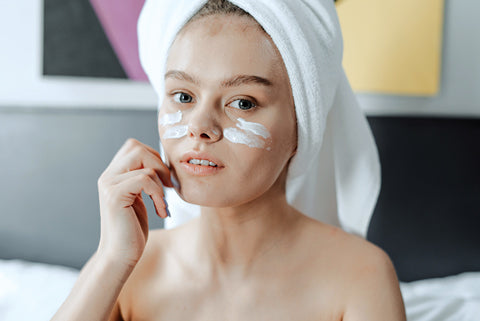The Skin’s Microbiome
AUTHOR - DR. DAVID JACK

Believe it or not, there are around 1,000 different species of microorganisms (i.e. microbes including bacteria, fungi and protozoa) that live on the surface of your skin at any given time. This doesn’t mean your skin is infected but is in-fact a phenomenon that is essential to the function and health of your skin. This miniature ecosystem is referred to as your skin flora, or microbiome. Increasingly, the skin’s microbiome has been recognised as an essential consideration when choosing skincare, much like the microbiome found in the gut. Indeed, there is believed to be a link between the function of your skin and the bacteria found in both the skin and the gut - known as the gut-skin axis.
In normal times the bacteria and fungi are either ‘commensals’, meaning that they live on the host (i.e. our skin) and are not harmful, or even can be ‘mutualistic’, meaning that they actually benefit the host. The skin flora is important in the immune function of the skin and offers protection against ‘pathogenic’ (i.e. disease causing) micro-organisms by secreting chemicals that are toxic to these pathogens or by competing for nutrients. Normal skin bacteria and fungi are also important in ‘training’ the skin’s immune system to recognise threats.
Most of the time, the skin flora stays on the surface of the skin and doesn’t cause any issues. However, in certain circumstances, such as in people who are immunosuppressed, or if there is disruption to the normal barrier function of the skin, these micro-organisms can breach the surface of the skin and cause infection or skin diseases, thus becoming ‘pathogenic’. Diseases including eczema, seborrhoea dermatitis, acne, rosacea and psoriasis are thought to be related to disruptions in the normal skin flora in some cases.
The type of microbes on the surface of your skin varies, depending on a number of factors including the site on your body (for example the belly button contains the highest level of bacteria anywhere on the body), moisture levels and external influences such as antibiotic usage, product use, clothing and exposure to other microbes through your occupation or lifestyle.
Does cleansing my skin reduce the skin’s microbiome?

Not necessarily. A healthy skin flora relies on the pH of the skin surface being maintained at an acidic level, mostly by lactic acid found in sweat and sebum. The microbes feed on sebum and material from dead skin cells. Cleansing with a non-stripping, low pH cleanser that does not overly strip sebum (oil) from the skin surface is therefore important. You should avoid harsh disinfectants and surfactants as both can upset the normal flora by killing ‘good’ skin microbes, leaving room for pathogenic microorganisms to colonise the skin.
What can I do to support my skin’s microbiome?

Maintaining an acidic skin pH by using products rich in acidic but non-astringent ingredients such as vitamin C and alpha-hydroxy acids (AHAs) such as lactic acid, is an important consideration. Unlike the gut microbiome, which is often treated with probiotic oral supplements to optimise the type and abundance of certain bactera, we don’t really need to put supplementary microbes on the skin surface. Conversely, the skincare we use could be viewed as prebiotic i.e. providing the ideal environment for the ‘good’ skin bacteria to flourish, just as we might take certain prebiotic foods to balance the gut flora.
Stress and pollution are also factors affecting your skin’s microbiome, with pollution in particular known to negatively effect the balance of ‘good’ and ‘bad’ bacteria on the surface of your skin. Neutralising chemicals derived from environmental pollutants through use of antioxidants is an important consideration, and again ingredients such as vitamin C, the retinoids and AHAs would be first line for this.
Maintaining a healthy skin barrier is also important, by avoiding over-exfoliation and through use of ingredients such as ceramides (the fatty acids found in sebum) and humectants (moisturising molecules) such as hyaluronic acid and glycerin. Ceramides are important as they both maintain the integrity of the barrier of the skin and also provide a food source for the microbes, and the humectants provide optimal hydration levels to support a healthy skin microbiome.
What does the future hold for skincare to support the skin microbiome?
This is difficult to tell. I think in the future, much like for gut health, we will start to see more skincare products that contain both skin probiotics and prebiotics. Supplements will also be important for this. It may be possible to develop supplements that optimise the chemistry of the skin sebum to promote a healthy skin microbiome and inhibit growth of pathogens. In my opinion, I believe we will all become increasingly aware of the importance of sensible antibiotic use and also recognise that we should avoid products that overly strip the skin’s barrier and sensitise the skin.

